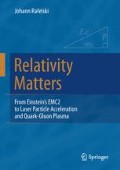Abstract
The (Lorentz-)force law describing the interaction of charged particles with electromagnetic (EM) fields is based primarily on experimental experience. We consider, example by example, how the well-known nonrelativistic Lorentz force dynamics generalizes to relativistic motion. Throughout we use SI units and the relation to Gauss EM units is described. We study first the motion of a charged particle in a constant magnetic field, then follow with the more complex case of motion in a constant electric field. We show that the motion of charged particles can also be described in terms of the EM-potentials \(V,\;\vec{A}\) that generate these fields. We introduce the (non-covariant) transverse gauge constraint to make the field-potential relation unique. We rewrite and present the modified Lorentz force written in terms of these four electromagnetic potentials. We introduce a relativistic, but not yet covariant formulation, finding a conserved canonical momentum. We identify another conserved quantity, the Hamiltonian (energy). We establish a constraint that bears the signature of a 4-dimensional energy-momentum invariant. We exploit the canonical momentum and energy conservation in the study of charged particle orbits in the presence of the Coulomb potential of an atomic nucleus. We point out parallels with relativistic atomic quantum orbits.
Access this chapter
Tax calculation will be finalised at checkout
Purchases are for personal use only
Notes
- 1.
In a book written for students we adhere to the SI-units. However, we do this reluctantly; note that J.D. Jackson in the 3rd edition of Classical Electrodynamics (John Wiley & Sons, New York, 1999), on page 514 switches units: “Beginning with Chap. 11 (Special Theory of Relativity) we employ Gaussian units instead of SI units….” The reasons ‘why’ are spelled out by Richard Becker in his reissue of Max Abraham’s Electricity and Magnetism text. In the introduction Becker says (translation for the 1930 English language edition by J. Dougall, (Blackie & Son, London 1932)): “In the choice of units I have followed Abraham’s last edition (which differs from earlier editions, JR) in every detail. The system used throughout is the Gaussian system,… . It does not seem possible at present to set up a system of units which will satisfy the electrical engineer and the physicist alike. …(This is) not a matter of notation merely but of principle. The technical view adheres much more strictly …to the original Faraday-Maxwell theory. The engineer looks upon the vectors \(\vec{{\mathcal{E}}}\) and \(\vec{{\mathcal{D}}}\) – even in vacuum – as magnitudes of quite different kinds, related to each other more or less like tension and extension in the theory of elasticity. …On the other hand, the (this) distinction in principle between \(\vec {{\mathcal{D}}}\) and \(\vec{{\mathcal{E}}}\) which is closely connected with the mechanical theory of the æther, has been absolutely abandoned…. (bolding JR) The numerical identity of \(\vec{{\mathcal{E}}}\) and \(\vec {{\mathcal{D}}}\) – for empty space – is, in the Gaussian system of units, expression of the fact that …(they) are actually the same thing. The introduction by an engineer of a dielectric constant and permeability not equal to 1 in a vacuum seems to the physicist to be …an artifice…”.
- 2.
Michael Faraday (1791–1867), preeminent English scientist, discoverer of the principles underlying electromagnetic induction that allows the generation and use of electrical power.
- 3.
See for example: G. Kortemeyer, W. Bauer, K. Haglin, J. Murray, S. Pratt, “Causality Violations in Cascade Models of Nuclear Collisions,” Phys. Rev. C 52, 2714 (1995).
- 4.
See for example H. Goldstein, Classical Mechanics, Addison-Wesley; 3 edition (New York, 2001).
- 5.
See W. Greiner, B. Müller and J. Rafelski, Quantum Electrodynamics of Strong Fields, Springer (New York, Berlin 1985, 2015).
- 6.
T.H. Boyer, “Unfamiliar trajectories for a relativistic particle in a Kepler or Coulomb potential”, Am. J. Phys. 72, 992 (2004). Another resource for classical relativistic Coulomb potential solution is: J.D. Garcia, “Quantum solutions and classical limits for strong Coulomb fields”, Phys. Rev. A 34, 4396 (1986); both these works overlap and complement each other, clearly do not know of each other, and in their references are fully orthogonal, an example of how science is inadvertently duplicated in two parallel developments.
- 7.
A. Einstein, “Erklärung der Perihelbewegung des Merkur aus der allgemeinen Relativitätstheorie,” (translated: Explanation of the perihelion motion of Mercury from the General Theory of Relativity) Preussische Akademie der Wissenschaften, Sitzungsberichte, 831 (1915).
- 8.
See Eq. (9.5.17) in: S. Weinberg, Gravitation and Cosmology John Wiley & Sons Inc. (New York, 1972).
- 9.
A. Einstein, “Die Grundlage der allgemeinen Relativitätstheorie,” (translated: The Foundation of the General Theory of Relativity), Annalen der Physik 354, 769 (1916).
Author information
Authors and Affiliations
Rights and permissions
Copyright information
© 2017 Springer International Publishing AG
About this chapter
Cite this chapter
Rafelski, J. (2017). The Lorentz Force. In: Relativity Matters. Springer, Cham. https://doi.org/10.1007/978-3-319-51231-0_23
Download citation
DOI: https://doi.org/10.1007/978-3-319-51231-0_23
Published:
Publisher Name: Springer, Cham
Print ISBN: 978-3-319-51230-3
Online ISBN: 978-3-319-51231-0
eBook Packages: Physics and AstronomyPhysics and Astronomy (R0)

